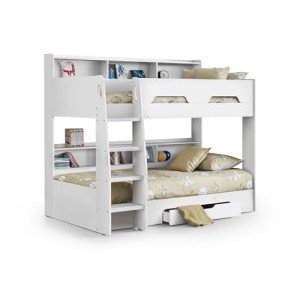The Ultimate Guide to Bunk Beds for Children: Safety, Styles, and Benefits
When it concerns styling a kid's space, moms and dads typically face the double challenge of optimizing space while making sure comfort and functionality. Bunk beds have become a popular solution that attends to these requirements, offering not simply sleeping arrangements however also adding to a space's visual. In this extensive guide, we will explore various aspects of children's bunk beds, focusing on their advantages, safety functions, designs, and factors to consider for parents considering this purchase.
Table of Contents
- Benefits of Bunk Beds
- Security Features to Consider
- Kinds Of Bunk Beds
- Style and Style Options
- Maintenance Tips
- Regularly Asked Questions (FAQs)
1. Benefits of Bunk Beds
Bunk beds use various benefits for children and their parents. Here are some key advantages:
- Space-Efficiency: Bunk beds are an exceptional service for smaller sized rooms. By stacking one bed on top of another, more flooring space is offered for play, storage, or study locations.
- Cost-efficient: When kids share rooms, bunk beds can decrease the requirement for purchasing two separate beds, thus saving money.
- Promotes Social Interaction: Bunk beds can help siblings or pals bond by sharing a space, producing chances for social development.
- Fun Factor: The principle of sleeping "up high" includes a spirited element to bedtime, making the shift to sleeping alone simpler for some children.
- Versatile Design: Bunk beds come in different designs, colors, and develops to match any space style, enabling customization that shows the kid's personality.
2. Safety Features to Consider
Safety is vital when it pertains to kids's furniture, specifically when it comes to bunk beds. Here are some vital security features to examine:
| Safety Feature | Description |
|---|---|
| Tough Construction | Frames made of strong wood or metal are preferred. |
| Guardrails | Must be at least 5 inches high and extend along both sides of the upper bunk. |
| Ladder Design | Guarantee ladders are safely attached and have non-slip actions. |
| Mattress Size & & Fit | Need to fit comfortably within the frame to avoid gaps. |
| Weight Limit | Always abide by the manufacturer's weight limit suggestions. |
3. Kinds Of Bunk Beds
Bunk beds can be found in several designs, dealing with various requirements, preferences, and room sizes. Here are some typical types:
- Standard Bunk Bed: The the majority of basic type, with one bed on top of another.
- Loft Bed: Features a high upper bed with space below for a desk or play area.
- Futon Bunk Bed: Combines a top bunk with a futon on the bottom, offering versatility for seating and sleeping.
- L-Shaped Bunk Bed: This design has the leading bunk set at a perpendicular angle to the bottom, creating a small corner area.
- Triple Bunk Bed: Accommodates three children utilizing stacked beds, perfect for large households or pajama parties.
4. Style and Style Options
When it concerns choosing a style for children's bunk beds, the alternatives are virtually unlimited. Here are some popular designs:
- Traditional Style: Often made of wood, these bunk beds include ornate information and are best for classic or rustic-themed spaces.
- Modern Style: Characterized by clean lines and minimalist designs, modern bunk beds can be made from metal or wood.
- Themed Bunk Beds: Some brand names provide bunk beds formed like castles, automobiles, or playhouses, making bedtime less of a chore.
- Convertible Bunk Beds: These can be separated into two individual beds, using flexibility as children grow.
- Colorful Options: Bunk beds in vibrant colors can include a sense of happiness and playfulness to any room.
5. Maintenance Tips
Preserving a bunk bed is crucial for durability and safety. Here are some suggestions:
- Regular Inspections: Check for loose screws or bolts every few months and tighten them as required.
- Cleaning: Wipe down frames regularly to prevent dust accumulation; think about utilizing a vacuum for hard-to-reach areas.
- Bed mattress Care: Rotate bed mattress routinely and use protective covers to extend their life.
- Look for Wear and Tear: Look for any signs of damage in the wood or metal and consider changing parts if required.
- Teach Kids Safety Rules: Encourage children to use ladders effectively and ensure they understand the security features of their bed.
6. Often Asked Questions (FAQs)
Q1: What age is appropriate for sleeping in a leading bunk?
A1: Typically, children aged 6 and older are advised for upper bunk sleeping, as they have the essential motor skills to climb safely.
Q2: Do bunk beds feature a bed mattress?
A2: Most bunk beds are offered as frames only, so you will require to purchase bed mattress independently. Make Bunks kennithwiener.top that the bed mattress fits the frame comfortably.
Q3: Can bunk beds be separated later?
A3: Many designs allow conversion into 2 individual beds, offering flexibility for future requirements.
Q4: How can I guarantee my child's security on a bunk bed?
A4: Comply with safety standards and guarantee guardrails, a strong frame, and a protected ladder are in location.
Q5: Are there weight limitations on bunk beds?
A5: Yes, always inspect the manufacturer's specs concerning weight limits to make sure security.
Bunk beds for children can serve several purposes while guaranteeing security and style. With varied styles and models available on the marketplace, parents can discover a system that not just optimizes bedroom space however likewise shows their kid's special tastes. Just like any furniture, comprehending security functions, upkeep, and how they fit into a child's lifestyle will make sure that these beds remain a useful furniture option for years to come.
Through careful consideration and adherence to safety guidelines, bunk beds can offer a lasting, enjoyable, and functional sleeping service that kids like.

